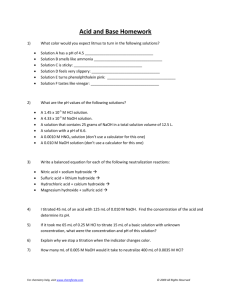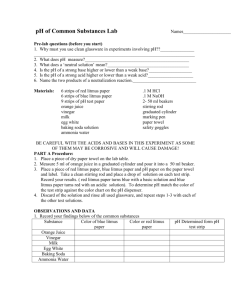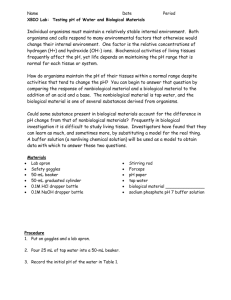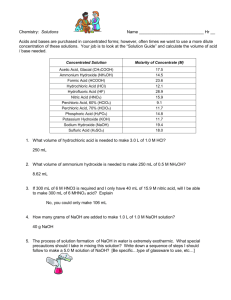Observing Double Displacement Lab
advertisement
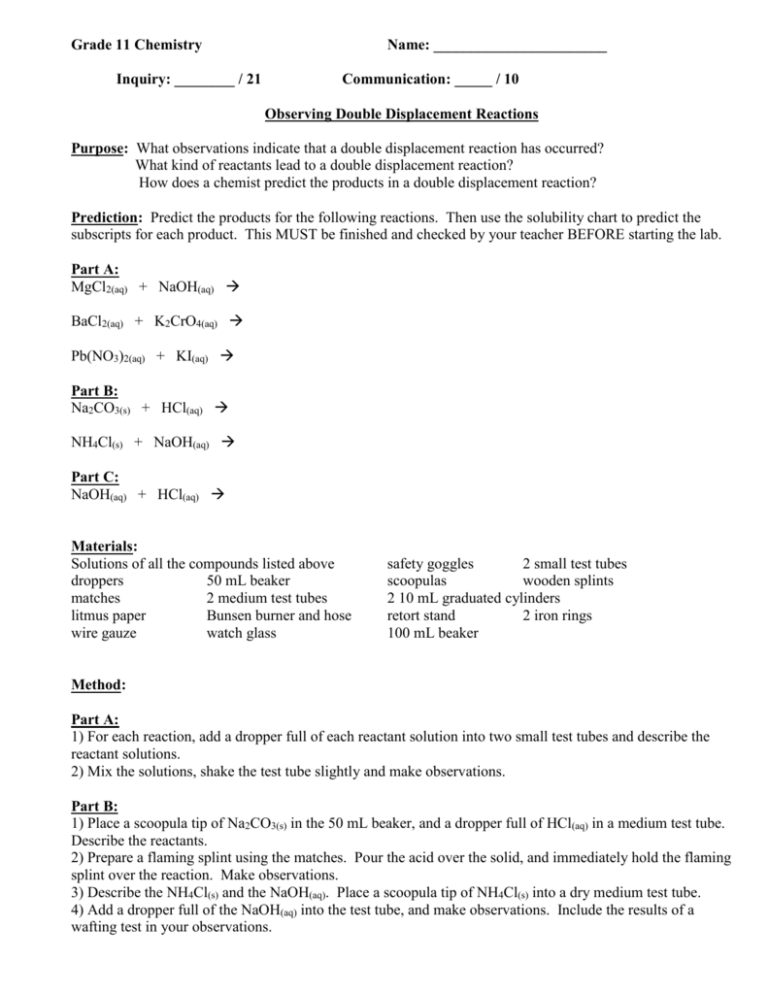
Grade 11 Chemistry Inquiry: ________ / 21 Name: _______________________ Communication: _____ / 10 Observing Double Displacement Reactions Purpose: What observations indicate that a double displacement reaction has occurred? What kind of reactants lead to a double displacement reaction? How does a chemist predict the products in a double displacement reaction? Prediction: Predict the products for the following reactions. Then use the solubility chart to predict the subscripts for each product. This MUST be finished and checked by your teacher BEFORE starting the lab. Part A: MgCl2(aq) + NaOH(aq) BaCl2(aq) + K2CrO4(aq) Pb(NO3)2(aq) + KI(aq) Part B: Na2CO3(s) + HCl(aq) NH4Cl(s) + NaOH(aq) Part C: NaOH(aq) + HCl(aq) Materials: Solutions of all the compounds listed above droppers 50 mL beaker matches 2 medium test tubes litmus paper Bunsen burner and hose wire gauze watch glass safety goggles 2 small test tubes scoopulas wooden splints 2 10 mL graduated cylinders retort stand 2 iron rings 100 mL beaker Method: Part A: 1) For each reaction, add a dropper full of each reactant solution into two small test tubes and describe the reactant solutions. 2) Mix the solutions, shake the test tube slightly and make observations. Part B: 1) Place a scoopula tip of Na2CO3(s) in the 50 mL beaker, and a dropper full of HCl(aq) in a medium test tube. Describe the reactants. 2) Prepare a flaming splint using the matches. Pour the acid over the solid, and immediately hold the flaming splint over the reaction. Make observations. 3) Describe the NH4Cl(s) and the NaOH(aq). Place a scoopula tip of NH4Cl(s) into a dry medium test tube. 4) Add a dropper full of the NaOH(aq) into the test tube, and make observations. Include the results of a wafting test in your observations. Part C: 1) Measure exactly 5 mL of HCl(aq) and 5 mL of NaOH(aq) using the 10 mL graduated cylinder (remember to measure from the bottom of the meniscus!). Describe the reactants. 2) Use litmus paper to test the pH of both solutions (either acidic or basic). 3) Combine the two solutions into a 100 mL beaker and test the pH with litmus paper. It should be neutral. If it isn’t, then add small drops of either the acid or the base until the solution is neutralized. 4) Set up the retort stand, 2 ring clamps and the wire gauze to drive all the water off the beaker of products. Use the watch glass over the beaker to prevent spattering. Describe the resulting product. Observations: (7 marks) Part A Reactants MgCl2(aq) Observations of Reaction NaOH(aq) BaCl2(aq) K2CrO4(aq) Pb(NO3)2(aq) KI(aq) Part B Reactants Na2CO3(s) Observations HCl(aq) NH4Cl(s) NaOH(aq) Part C Reactants NaOH(aq) litmus paper turns ________ Observations After mixing, litmus paper turns ________ After heating: HCl(aq) litmus paper turns ________ Analysis: 1) Write the balanced chemical equations for each reaction in Part A of the Prediction. (3 marks) 2) For each reaction in Part B, write the balanced equation for the initial double displacement reaction. Then write a balanced chemical equation for the decomposition reaction that leads to the formation of a gas and water. (4 marks) 3) Write a balanced chemical equation for the reaction that took place in Part C. (1 mark) Conclusion: (6 marks) Answer all the questions in the Purpose with detailed answers using full sentences.

